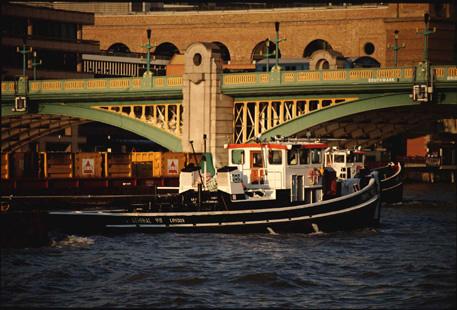
Photograph copyright ©1999 - 2018 Denis Waugh.
External Links
SOUTHWARK BRIDGE
In 1066 the manor of Southwark belonged to Earl Godwin, father of King Harold, and after Harold's death at the Battle of Hastings it fell to his friend Ansgar, who had been badly wounded at Hastings and had to be carried in a litter as he organized resistance, to prevent William of Normandy from crossing London Bridge. So William burned Southwark and proceeded south-eastwards on his great circle of destruction, crossing the Thames at Wallingford and returning eventually to London.
Southwark recovered and, as the main entry from the south to London via the only river crossing, London Bridge, it became well known as a place of hospitality to travellers. Chaucer's pilgrims met at the Tabard inn, which was in Talbot Yard, Borough High Street. It no longer survives, but a little further along Borough High Street is the George, dating from 1677 and worth a visit for its architecture and ambiance if nothing else. Southwark's inns became largely redundant with the advent of the railways.
The first Southwark Bridge was not built until 1819 by the architects John Rennie & Son and was the iron bridge that features in Charles Dickens' Little Dorrit. Today's bridge was built in 1912-21 by Mott and Hay to the design of architect Sir Ernest George.
Southwark became a centre for entertainment mainly because the earliest theatres had to be established beyond the City's jurisdiction. In 1580 the puritan Lord Mayor of London pronounced players `a very superfluous sort of men' so when the Rose, the Swan and the Globe opened in the late sixteenth century they were all on the south bank, securely out of harm's way. When the Puritans gained power in the City in 1640 they closed them all, but with the restoration of Charles II in 1660 they all opened again apart from the Globe.
Closed, also, was the Davies amphitheatre of 1662-82, the last bear-baiting ring of Bankside, visited with great pleasure by the hedonistic Samuel Pepys and, perhaps with less pleasure, by his more fastidious friend John Evelyn. Bear-baiting was not a new phenomenon. Queen Elizabeth I had visited the Bear Gardens, but the amphitheatre was later replaced by the Hope Playhouse, intended for both bear-baiting and plays. Ben Jonson's Bartholomew Fair was first performed there in 1614. There are no gardens now, just a derelict Victorian warehouse, home to the ubiquitous buddleia where a pigeon roosts peacefully in a tree awaiting the developers - who are at least preferable to bear-baiting.
The streets around the theatres - Porter Street, Hopton Street, Anchor Terrace - were `The Stews' which Falstaff and Prince Hal frequented in Shakespeare's Henry IV and in mass graves hereabouts, without the dignity of Christian burial, the bodies of the women from the brothels were disposed of.
Behind Anchor Terrace on Southwark Bridge Road today a once-proud sign proclaims with a large arrow: THE GLOBE THEATRE. Archaeological Excavation. But alas, the excavation now taking place is not a gentle uncovering of our heritage. Rather a development of new luxury flats. Mark Rylance and Zoë Wanamaker, who knew how much we had still to learn, were brought to tears by the decision of the then Heritage Minister Virginia Bottomley. Will the new inhabitants appreciate what they are living above? Will they hear ghostly feet in the night - will ribald jokes and alarums and excursions disturb their slumbers?
Above the excavation a flock of birds shimmers overhead backwards and forwards. Changing and ever changing direction like dispossessed souls. As the late summer sun catches them, these humble London feral pigeons become shades of grey, black, and purest, purest white. A flock of doves, no less. Below, excavators in their employers' red shirts and hard hats dig on.
Text copyright ©1999 - 2018 Priscilla Waugh.